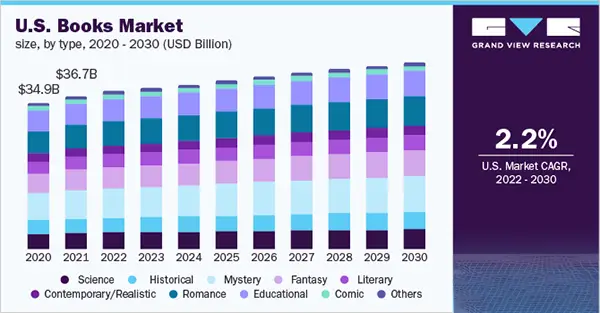Understanding the Editorial Process and Income: A Clear Guide
Understanding the editorial process is decisive for any writer or author looking to publish their work. It involves a series of steps, from ideation to publication, to ensure that the final product is of high quality and meets the standards of the publishing industry, which will in turn determine your editor salary. This involves ensuring the final product is polished, well-written, and meets the expectations of the target audience.
In addition to understanding this, consider the income potential of writing and publishing. While writing and publishing can be a fulfilling and rewarding career, it is also significant to consider the financial aspects of the industry. Also, learn about Technology to Optimize Tax Filing with this guide.
Learning how to monetize your writing, whether through traditional publishing or self-publishing, can help you achieve financial success while pursuing your passion for writing. By understanding the practice and earning potential of writing, you can set yourself up for success in the publishing industry.
Navigating the Editorial Landscape
Navigating this landscape can be an overwhelming task, especially for those who are new to the field. This section aims to provide an overview of the editorial process and the various roles and responsibilities involved.
Understanding the Editorial Workflow
Its workflow refers to the stages that a manuscript goes through from the initial submission to the final uploading. The workflow can vary depending on the journal or publication, but generally, it includes the following stages:
- Submission
- Editorial office review
- Peer review
- Decision-making
- Revision
- Acceptance and publication
Roles and Responsibilities
The respective team is responsible for managing the tasks and ensuring that the publication maintains its standards. The group consists of the editor-in-chief, associate editors, and the editorial board. The support team also plays a vital role in managing the submission and review tasks.
The editor-in-chief is responsible for setting the direction and overseeing the entire operation. The associate editors work closely with the editor-in-chief and manage the day-to-day operations of the journal. The board consists of subject-matter experts who provide guidance and support to the editorial team.
Peer Review and Decision-Making
Peer review is a stage that involves the evaluation of a manuscript by experts in the field who provide feedback on the value and validity of the research. It can take several weeks to several months, depending on the complexity of the manuscript and the availability of critics.
The decision-making is based on the feedback provided by the peer critics. The team evaluates the feedback and decides on whether to accept, reject, or request revisions to the manuscript. And, it can take numerous weeks to various months, depending on the complexity of the manuscript and the number of revisions required.
Optimizing Editorial Outcomes
Optimization of outcomes is the primary part of content creation, dissemination, and business value. It requires a strategic approach that emphasizes quality control, well-written papers, readability, and effective communication and collaboration. Here are three key ways to optimize the outcomes:
Enhancing Content Quality

(This graph shows the size of the U.S. book market, by type, from 2020 to 2030, in US$ billion).
To enhance content quality, it is necessary to have a robust resource and support team. They should consist of well-trained and experienced editors, reviewers, and writers who can create, edit, and review manuscripts to ensure that they meet the highest quality standards. The piece should be well-written, clear, concise, and free of errors. The group should leverage automation and innovation to improve efficiency and flexibility in the procedure.
Leveraging Technology and Innovation
Leveraging technology and innovation includes using tools and software that can automate certain tasks, such as checking for grammatical errors and plagiarism. The team should be open to transformation and change, embracing new technologies and approaches that can improve the procedure and enhance the article’s value.
Effective Communication and Collaboration
The team should establish clear lines of communication and feedback to ensure that everyone is on the same page. This includes providing regular updates on the status of manuscripts and ensuring that everyone has access to the necessary resources and information.
The group should promote transparency and collaboration, encouraging open dialogue and feedback. In conclusion, it requires a strategic approach that emphasizes quality control, well-written content, readability, and effective communication and collaboration.
By enhancing content value, leveraging technology and innovation, and promoting effective communication and collaboration, it can be streamlined, and high-quality pieces can be created and disseminated efficiently.
Do You Know?
From 2022 to 2032, the employment of writers and authors is projected to grow by 4%, which is about as fast as the average for all occupations.
Conclusion

Understanding the editorial process is decisive for individuals who aim to publish their work. By comprehending the steps involved in it, one can increase their chances of getting their work accepted for publication. It involves several steps, including submission, review, editing, and printing or uploading.
One of the significant factors that can impact the procedure is income. Income can affect the quality of the piece submitted for printing, the level of access to resources and expertise, and the ability to pay for publication fees. However, it is noteworthy that earnings should not be the sole determinant of the value of work submitted for publication.
To ensure a fair and unbiased editorial practice, publishers must strive to provide equal opportunities for all authors, regardless of their salary level. This can be achieved by providing access to resources and expertise, offering waivers for publication fees, and ensuring that it is transparent and impartial.
FAQ
Here are some frequently asked questions regarding the editorial process and its impact on income:
Ans: The editorial process can have a significant impact on income for content creators. A well-executed editorial process can result in high-quality content that resonates with readers, leading to increased engagement and revenue. On the other hand, a poorly executed editorial process can result in low-quality content that fails to engage readers, leading to decreased revenue. Therefore, content creators must invest time and resources in developing an effective editorial process.
Ans: Some common challenges in the editorial process include managing deadlines, maintaining consistency in tone and style, and ensuring accuracy and fact-checking. Managing feedback and revisions from multiple stakeholders can be a complex process that requires effective communication and collaboration.
Ans: Content creators can improve their editorial process by implementing best practices such as creating an editorial calendar, establishing clear guidelines for tone and style, and developing a system for managing feedback and revisions. Investing in tools and resources such as editing software and professional editors can help ensure high-quality content that resonates with readers.
Ans: The editorial process is a determining component of content marketing, as it ensures that content is high-quality, relevant, and engaging for the target audience. By investing in an effective editorial process, content marketers can create content that resonates with readers, drives engagement, and ultimately, generates revenue for the business.
